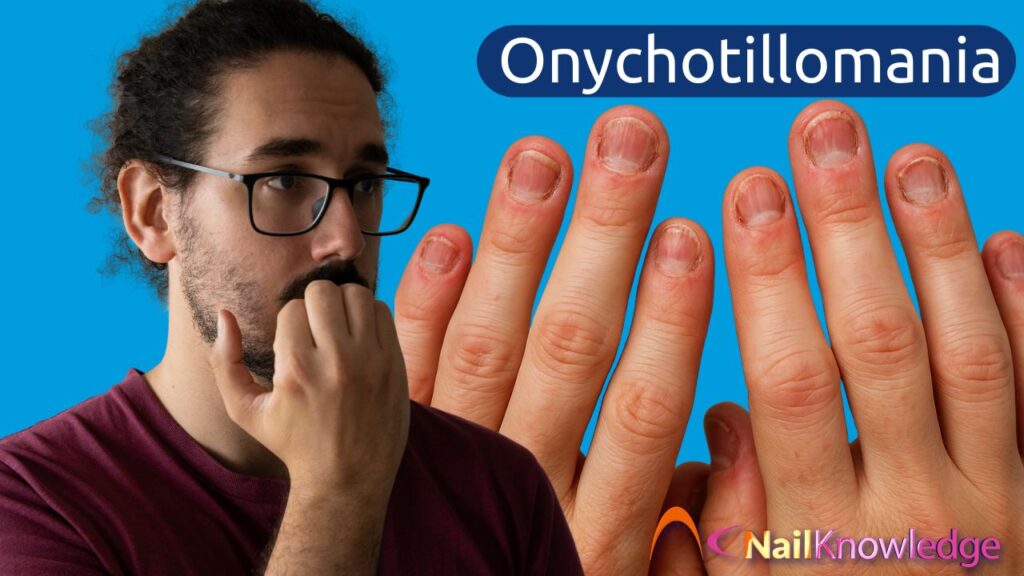How Can We Help?

Onychotillomania
92 Views
Onychotillomania (pronounced on‑i‑ko‑til‑oh‑MAY‑nee‑ah) is a compulsive or repetitive habit of picking, pulling, or manipulating one’s fingernails, toenails, or the surrounding skin. It is classified as a body‑focused repetitive behaviour (BFRB) and can cause significant nail damage, discomfort, and increased risk of infection.
While occasional nail picking is common, onychotillomania refers to a persistent, often unconscious behaviour that interferes with nail health and can become a source of physical harm and emotional distress.
How Onychotillomania Is Classified
- Medical Category: Impulse control disorder / BFRB
- Related Conditions:
- Onychophagia (chronic nail biting)
- Dermatillomania (compulsive skin picking)
- Trichotillomania (hair pulling)
- Diagnostic Context:
Onychotillomania can be included under Other Specified Obsessive–Compulsive and Related Disorders in the Diagnostic and Statistical Manual of Mental Disorders (DSM‑5).
This classification reflects its similarities to other repetitive grooming habits, where an individual feels compelled to perform the behaviour despite negative consequences.
Causes and Triggers of Onychotillomania
The behaviour often develops gradually and can be triggered or maintained by several factors:
- Psychological Triggers:
Stress, anxiety, boredom, or perfectionism can prompt nail manipulation as a self‑soothing activity. - Learned Behaviour:
Observing similar habits in family members or peers can normalise nail picking. - Sensory Satisfaction:
Some people experience a tactile or visual reward from removing irregularities on the nail plate or cuticle. - Neurodevelopmental and Mental Health Links:
Higher rates of onychotillomania are reported in individuals with anxiety disorders, obsessive‑compulsive disorder (OCD), and attention deficit hyperactivity disorder (ADHD). - Perceived Nail Imperfections:
Small ridges, peeling layers, or minor damage may trigger an urge to “correct” the nail by picking.
Health Risks and Complications of Onychotillomania
Frequent or forceful nail manipulation can cause:
- Nail Plate Damage:
Splitting, peeling, or permanent deformities if the nail matrix is injured. - Cuticle and Skin Trauma:
Cuts and abrasions increase infection risk and can cause chronic inflammation. - Infections:
Bacterial or fungal infections may develop in damaged tissue. - Pain and Sensitivity:
Over‑exposed nail beds and irritated skin can make everyday tasks uncomfortable. - Slow or Abnormal Nail Growth:
Continuous trauma disrupts the normal nail growth cycle. - Scarring:
In severe cases, permanent scarring or loss of nail tissue may occur.
Onychotillomania vs. Onychophagia
While both conditions are BFRBs affecting the nails, the primary behaviours differ:
- Onychotillomania: Picking, pulling, or tearing at the nails or surrounding skin — usually with fingers or tools.
- Onychophagia: Biting or chewing nails, often with the teeth.
Both can occur together, and both can cause similar nail health issues. Understanding the dominant behaviour helps guide effective treatment strategies.
Treatment for Onychotillomania
Successful management often requires a combination of behavioural, physical, and supportive approaches.
1. Behavioural Interventions
- Habit Reversal Training (HRT):
Teaches awareness of the behaviour and develops a “competing response” (e.g., clenching fists, holding a stress ball) when the urge arises. - Cognitive‑Behavioural Therapy (CBT):
Addresses underlying thoughts and emotions driving the habit. - Stimulus Control:
Modifying environments to reduce triggers (e.g., keeping nails smooth, avoiding idle hand positions).
2. Stress Management
- Mindfulness meditation, breathing exercises, or physical activity can help reduce the anxiety or boredom that triggers picking.
3. Physical Barriers and Deterrents
- Wearing gloves or adhesive bandages on affected nails during high‑risk times.
- Applying bitter‑tasting nail coatings to discourage manipulation.
- Maintaining short, well‑filed nails to reduce tactile triggers.
4. Professional Nail Care
- Regular manicures can help keep nails neat, reduce imperfections, and act as a deterrent to picking.
- Protective nail enhancements may be suitable in some cases, but only when nails and surrounding skin are healthy.
5. Medical and Psychological Support
- For severe or chronic cases, a GP, dermatologist, or mental health professional can provide treatment options, including therapy or medication for co‑existing anxiety or OCD.
Preventing Relapse
Even after improvement, stress or environmental changes can trigger a return to nail picking. Strategies for long‑term success include:
- Continuing with stress‑reduction techniques.
- Keeping nails well maintained and moisturised.
- Setting realistic goals and tracking progress.
- Seeking ongoing support from friends, family, or online communities.
Prognosis
With consistent effort and the right strategies, most people can significantly reduce or stop onychotillomania. Early intervention helps prevent permanent damage, but improvement is possible even in long‑standing cases. Relapse is common but can be managed with self‑awareness and prompt action.
See also:
